Proper nutrition plays a vital role in the recovery and well-being of injured birds. When a bird is wounded, its body requires adequate nourishment to heal effectively and regain strength. As caretakers, we must provide the necessary food and nutrients to support their rehabilitation.
However, determining what to feed an injured bird can be daunting. This article aims to guide this crucial matter, answering the question, “What to feed an injured bird?”
We will explore the importance of proper nutrition, discuss suitable food options, highlight essential nutrients, and address when and how to initiate feeding.
Additionally, we will examine the significance of water intake, offer insights on monitoring the bird’s progress, and emphasize the need for veterinary consultation.
By understanding the nutritional needs of injured birds, we can contribute to their recovery process and increase their chances of returning to the wild with strength and vitality.
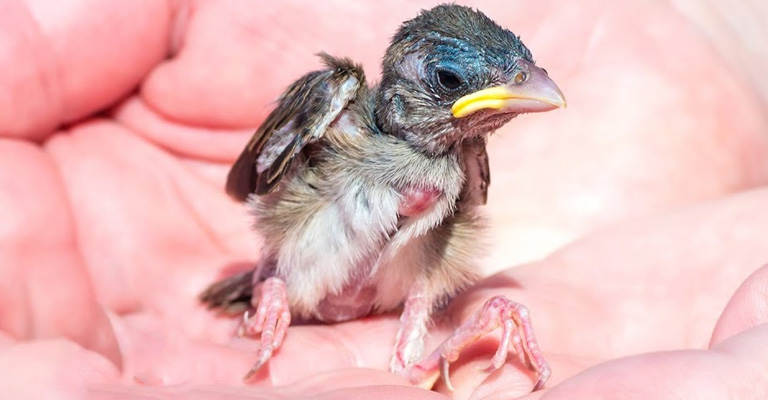
Identify the Injured Bird
When approaching an injured bird, it is essential to approach cautiously and handle it gently. Here are some signs to help identify a wounded bird:
Visible Injuries
Look for obvious signs of physical injury, such as bleeding, broken wings, or visible wounds. An injured bird may also have difficulty flying or perching.
When identifying an injured bird, it is essential to remember that some birds may appear injured when they are juveniles learning to fly. In such cases, observing from a distance is best, and providing assistance only if necessary.
Abnormal Movement
Observe if the bird is struggling to move or is exhibiting unusual behavior, such as hopping instead of flying or showing signs of weakness. This could indicate an injury that requires attention.
Feathers
Check the bird’s feathers for signs of damage or disarray. Injured birds may have broken, ruffled, or missing feathers. Feathers that are matted with blood or debris may also indicate an injury.
If you determine the bird is indeed injured, it is crucial to provide immediate care and seek assistance from a local wildlife rehabilitation centre or veterinarian experienced in avian care.
Arrange a Shelter for the Injured Bird
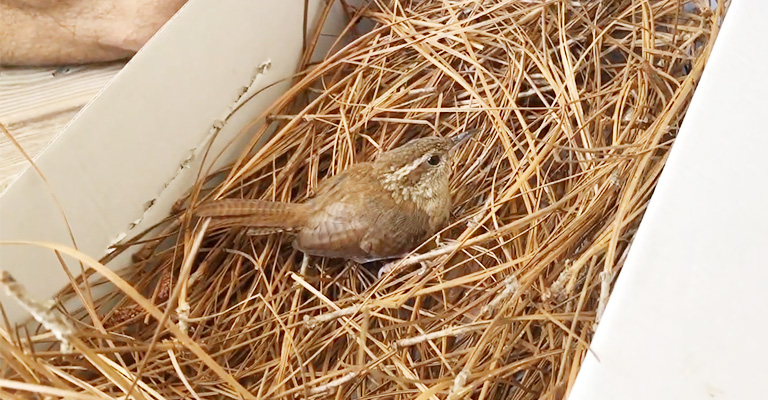
A suitable shelter for an injured bird is vital to ensure its safety, comfort, and protection. Here are some key considerations when setting up a temporary shelter:
Warmth and Comfort
Provide a warm, quiet, and well-ventilated space for the bird. Use a cardboard box or a similar container lined with soft towels or shredded newspaper as bedding. The bedding material should be gentle on the bird’s feet and allow easy cleaning.
Dark and Secure Environment
Keep the shelter dimly lit or cover it partially with a cloth to create a dark and secure environment. This helps reduce stress and encourages the bird to rest and recover. Ensure the shelter is placed in a quiet area away from excessive noise or disturbances.
Proper Ventilation
Ensure adequate airflow within the shelter to maintain a fresh and healthy environment. Avoid exposing the bird to direct drafts or extreme temperatures. Ventilation can be achieved by creating small air holes in the shelter or partially opening the top or sides.
Safety Precautions
Keep the injured bird away from other pets or potential sources of stress, such as loud noises or bright lights. Minimize handling to prevent additional stress or harm to the bird. Avoid placing the shelter near windows or areas where it may be exposed to direct sunlight.
Protection from Predators
Provide additional protection against potential predators by placing the shelter off the ground or in an enclosed space. This can be achieved by elevating the shelter on a table or placing it inside a secure cage or kennel.
By arranging a suitable shelter, you provide the injured bird with a calm, safe environment that promotes healing and minimizes stress.
What to Feed an Injured Bird?
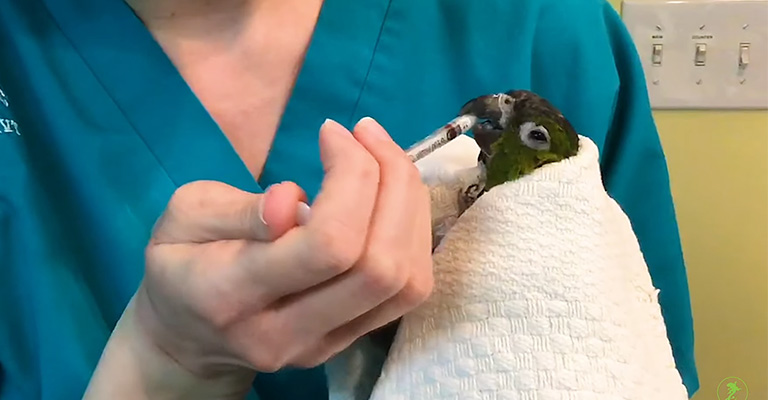
When caring for an injured bird, proper nutrition is crucial for its recovery and overall well-being. The specific dietary needs of an injured bird may vary depending on its species, age, and any existing health conditions. Here are some types of suitable foods that can be offered to an injured bird:
Commercial Bird Food:
Commercial bird food formulated specifically for the species of the injured bird can be an excellent option. These specialized diets are available in pet stores or recommended by wildlife rehabilitators.
They are designed to provide balanced nutrition and essential vitamins and minerals for the bird’s recovery. Follow the instructions on the packaging for the appropriate portion size and feeding frequency.
Fresh Fruits and Vegetables:
Fresh fruits and vegetables can provide natural sources of vitamins, minerals, and antioxidants. Some suitable options include diced or pureed apples, pears, berries, grapes, melons, leafy greens, carrots, and peas.
Avoid feeding fruits with seeds or pits, as they may be toxic to certain bird species. Wash and chop the fruits and vegetables into small, bite-sized pieces for easy consumption.
Insects and Mealworms:
Many bird species, especially insectivorous ones, thrive on a diet of insects. Offer small live or dried insects such as mealworms, crickets, or small grubs to provide a natural protein source.
Insects can be obtained from pet stores or specialized suppliers. Ensure that the insects are suitable for the bird’s size and species. Live insects can be placed in a shallow dish or sprinkled on the bird’s food.
High-Quality Protein:
Injured birds may require additional protein for tissue repair and healing. High-quality protein sources include:
- Cooked eggs (scrambled or boiled).
- Chicken or turkey (without seasoning or bones).
- Baby food with pureed meats.
Ensure the meat is thoroughly cooked and cut into small, easily digestible pieces. Avoid seasoning, as some ingredients like salt, garlic, or onion can harm birds.
Soaked and Softened Pet Food:
Some injured birds may benefit from softened pet food, which provides a nutritionally balanced and easily digestible option. Choose a high-quality, wet pet food appropriate for the bird’s species.
Soak the pet food in water or a natural fruit juice (without added sugars or artificial sweeteners) until it becomes soft and mushy. Offer small portions to avoid wastage and monitor the bird’s consumption.
Hydration:
Proper hydration is essential for an injured bird’s well-being. Offer fresh, clean water in a shallow dish or a bottle cap that is easy for the bird to access. Check and refill the water frequently to ensure it remains clean and fresh.
Sometimes, you may need to use a syringe or dropper to provide water directly to the bird if it cannot drink independently. Seek guidance from a wildlife rehabilitator or avian veterinarian for specific hydration needs.
It is important to note that while providing suitable food is crucial, it is equally important to avoid overfeeding the bird. Follow the guidance of a wildlife rehabilitator or avian veterinarian regarding portion sizes and feeding frequency.
Feeding Methods
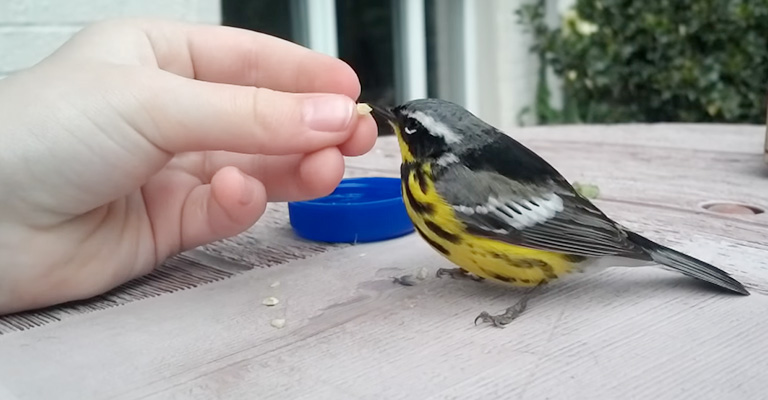
When feeding an injured bird, it is essential to employ appropriate methods to ensure it receives proper nutrition. Different feeding techniques may be necessary depending on the bird’s condition, species, and ability to eat independently. Here are some feeding methods to consider:
Self-Feeding:
Injured birds capable of eating independently should be provided suitable food and feeding dishes. Place the food in a shallow dish or attach it to the side of the enclosure using clips or suction cups, ensuring it is easily accessible for the bird.
Monitor the bird’s eating habits and adjust the food type or portion size accordingly. Regularly clean the feeding dishes to maintain hygiene.
Hand-Feeding:
Some injured birds may require hand-feeding, especially if they are too weak or have difficulty eating independently. Hand-feeding involves providing food directly to the bird using specialized techniques.
This method requires patience, gentle handling, and careful observation of the bird’s response. It is recommended to seek guidance from a wildlife rehabilitator or avian veterinarian on proper hand-feeding techniques, as they vary depending on the species.
Tube-Feeding:
Tube feeding is used for severely debilitated or injured birds that cannot eat independently or take food orally. This method requires professional training and expertise, best performed by wildlife rehabilitators or avian veterinarians.
It involves the insertion of a flexible feeding tube into the bird’s oesophagus or crop to deliver the appropriate nutrients directly.
Medication Administration:
In addition to providing proper nutrition, injured birds may require medication for recovery. Medication can be administered orally or mixed with their food. Consult a wildlife rehabilitator or avian veterinarian for the correct dosage and administration method.
It is essential to ensure the bird consumes the entire dose of medication, whether through direct administration or mixing it with food.
Always follow professional guidance and recommendations regarding feeding methods for injured birds.
How to Feed an Injured Baby Bird?
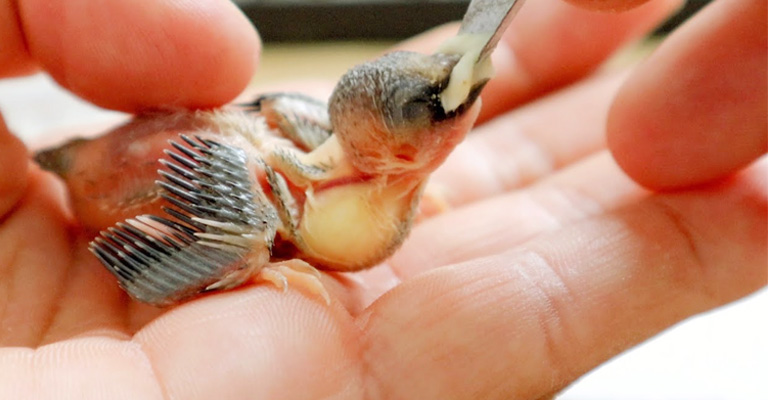
When caring for an injured baby bird, it is crucial to provide specialized care and nutrition to support its growth and recovery. Feeding an injured baby bird requires a delicate approach and adherence to specific guidelines.
Here are some steps to consider when providing a wounded baby bird:
Identify the Species
Identifying the species of the baby bird is essential as different species may have other dietary requirements. If possible, consult a wildlife rehabilitator or avian expert to determine the species of the bird to provide appropriate care and feeding.
Warmth and Safety
Ensure the baby bird is kept warm during the feeding process. Use a heating pad or a warm water bottle wrapped in a soft cloth and place it beneath the container or nest where the bird is being cared for.
Maintain a suitable temperature, generally around 90°F (32°C), to mimic the bird’s natural body heat. It is crucial to ensure the heating source is secure and does not harm the bird.
Feeding Equipment
Use proper feeding equipment to feed the baby bird. A small, sterilized syringe without a needle or a specialized bird-feeding spoon can be used.
These tools allow for precise and controlled feeding. Ensure the feeding equipment is clean and sanitized before each use to avoid contamination.
Suitable Diet
Baby birds have specific nutritional requirements, and their diet should closely mimic their natural diet as much as possible.
It is advisable to consult with a wildlife rehabilitator or avian veterinarian for guidance on the appropriate diet for the particular species of bird you are caring for.
In general, baby birds may require a combination of the following:
Commercial Baby Bird Formula
Commercially available baby bird formulas can provide the necessary nutrients for healthy growth. These formulas come in powdered form and must be mixed with water according to the instructions on the packaging.
It is crucial to use formulas specifically designed for the bird’s species or, if unavailable, for general baby bird use.
Insects or Mealworms
Depending on the species, some baby birds may require small, live insects or mealworms as part of their diet. Insects can be purchased from pet stores or specialized suppliers. Ensure that the insects are appropriate for the bird’s size and species, and feed them in small, suitable portions.
Softened Fruits and Vegetables
Some baby birds can benefit from small, mashed, or pureed portions of fresh fruits and vegetables. Offer soft fruits like bananas, berries, or melons and cooked and mashed vegetables such as sweet potatoes or carrots.
Ensure that the fruits and vegetables offered are safe for the bird species and are free of any harmful pesticides.
What to Do to Hydrate an Injured Bird?
Proper hydration is essential for the well-being and recovery of an injured bird. When caring for an injured bird, ensuring it stays hydrated is crucial.
Here are some steps to consider when hydrating a wounded bird:
Observe and Assess the Bird’s Hydration Level:
Before proceeding with hydration, observe the bird’s behaviour and appearance to assess its hydration status. Signs of dehydration in birds include sunken eyes, lethargy, fluffed-up feathers, dry or sticky mouth, or reduced urine output.
These indicators suggest that the bird may require immediate hydration.
Offer a Water Dish:
Providing a shallow dish or a bottle cap filled with fresh and clean water is the simplest way to offer hydration to an injured bird. Place the dish near the bird, ensuring it is easily accessible and visible.
The dish should be placed securely within the bird’s shelter to prevent tipping or contamination. Monitor the water level and refill it as necessary to ensure the bird can always access fresh water.
Provide Water in Different Formats:
Some injured birds may have difficulty drinking from a dish due to weakness or physical limitations. In such cases, offer water in alternative formats to encourage hydration:
Dropper or Syringe:
- Use a clean dropper or syringe (without the needle) to administer small amounts of water directly into the bird’s beak.
- Gently squeeze the dropper or syringe to release a few drops of water at a time, allowing the bird to swallow before administering more.
- Be cautious not to force the bird to drink or overwhelm it with too much water at once.
Soaked Foods:
Another way to provide hydration is by offering water-soaked foods. Soak a small portion of the bird’s regular diet, such as seeds or pellets, in clean water for a few minutes until they become soft and moist.
Place the wet food in a dish or offer it directly to the bird. This method can provide both hydration and nutrition simultaneously.
Misting or Spraying:
For some species, especially those from humid environments, misting or spraying water near the bird can stimulate drinking behaviour. Use a clean spray bottle filled with lukewarm water and gently mist the area around the bird.
Water droplets’ visual and auditory cues can encourage the bird to drink or preen, thus aiding in hydration.
Electrolyte Solutions:
In some instances, providing an electrolyte solution can benefit an injured bird. Electrolyte solutions, specifically formulated for avian species, can help replenish essential minerals and electrolytes lost during stress or dehydration.
Consult a wildlife rehabilitator or avian veterinarian for the appropriate electrolyte solution and dosage for the specific bird species. These solutions are typically diluted in water and offered as an alternative or supplement to regular water.
Seek Professional Guidance:
If the injured bird is severely dehydrated or unable to drink independently, it is crucial to seek professional assistance from a wildlife rehabilitator or avian veterinarian.
They can provide expert advice, assess the bird’s hydration needs, and administer intravenous fluids if necessary.
Frequently Asked Questions
No, it is not recommended to feed injured birds bread. Bread lacks essential nutrients and can lead to malnutrition. Instead, focus on providing appropriate species-specific diets.
The feeding frequency depends on the bird’s age, species, and condition. Younger birds generally need more frequent feeding, sometimes every 30 minutes to an hour. Adult birds may be fed every few hours. Observe the bird’s behaviour and appetite to adjust the feeding schedule accordingly.
Yes, keeping the bird hydrated is essential. Provide a shallow dish of water for the bird to drink. Ensure the water is not too deep to avoid drowning risks, especially for smaller bird species.
No, force-feeding can cause additional stress and potentially harm the bird. If the bird is unwilling to eat, consult a professional rehabilitator for alternative feeding methods.
Not necessarily. An injured bird needs to regain its strength and fully recover before release. Consult a wildlife rehabilitator to determine when the bird is ready for release and seek their guidance throughout the rehabilitation process.
Conclusion
Feeding an injured bird requires knowledge, care, and proper nutrition. While this article provides a general guideline on suitable foods, it is essential to seek professional advice from licensed wildlife rehabilitators or avian veterinarians.
Remember, the goal is to provide the bird with the best chance of recovery and eventual release into the wild.